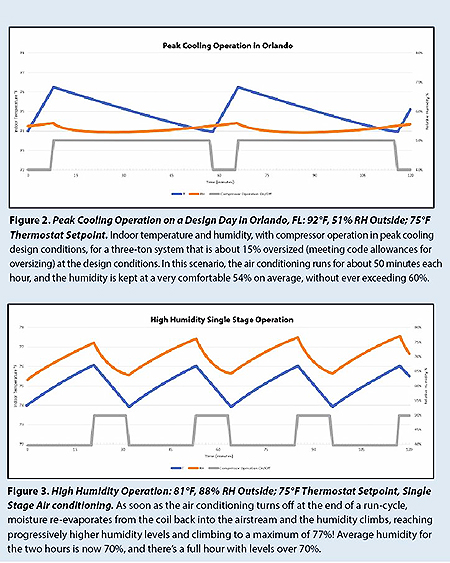In addition to increased illness, Ben says his experience is that dry air causes some serious discomfort. Before installing adequate humidifiers, Ben battled eczema every winter. He developed patches of dry, itchy, inflamed skin that wouldn’t go away until the springtime.

His son also had issues with dry air causing nosebleeds daily or even several times per day. Even though Ben says his family felt comfortable from a temperature perspective, the dry air caused serious discomfort in other forms.
To illustrate how both high and low humidity impacts different factors for human health, E.M. Sterling published a chart in 1985 that summarizes the relationships in an easy-to-understand format. We’ve adapted the chart in Figure 1 to provide a graphical reference.
Managing Cooling Humidity
Have you ever heard this kind of story? Frank and Suzy tend to fight over the thermostat. Frank wants to keep it at 76 degrees. Suzy sneaks over and turns it down to 70 degrees before they go to bed. It has been a running battle for 36 years. Suzy hates the conflict with her husband, but it’s too uncomfortable if the thermostat isn’t set at 70 degrees.
Equipment Considerations: In the residential HVAC universe, if there is cooling at the coil, there is also dehumidification. During a normal air conditioning on-cycle with properly sized equipment, when the outside temperature is in the 90s the equipment will have long runtimes and will keep humidity nice and low.
NOTE: An air conditioning coil takes between 15 to 30 minutes to become saturated enough that water drips from the coil. Once this happens, water flows flowing through the condensate drain. Any water left on the coil after the unit shuts off re-evaporates back into the duct system and eventually migrates inside the home.
This is latent degradation due to cycling effects.
We’ve developed a psychrometric model of a system that accounts for equipment performance under different operating conditions and latent capacity degradation due to shorter on-cycles.
Back to Frank and Suzy’s Home
Now let’s look at Frank and Suzy’s home during high humidity conditions when the outside temperature is only 81°F and the relative humidity outside is the highest point of the day (typically dusk through dawn).
In Figure 3, now the on-cycle is much shorter to get the inside temperature to 75°F, but it has not run long enough to keep humidity low. This properly sized system, with a single-speed compressor and blower, is now a severely oversized system based on the outside temperature.
Frank and Suzy’s HVAC contractor failed to mention what’s really going on, primarily because there is no perceived affordable solution. Suzy’s discomfort may be caused by sensitivity to humidity, or episodes of humidity-induced asthma.
Click Below for the Next Page:













Recent Comments